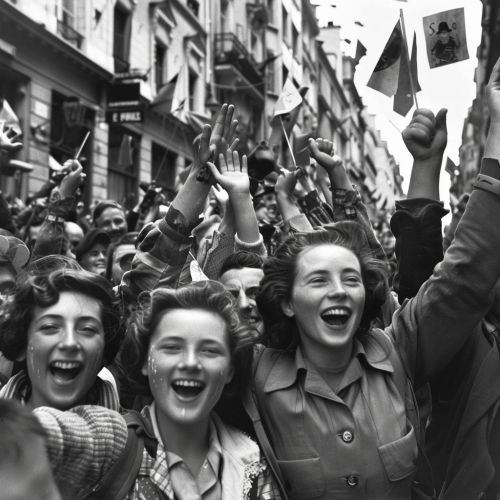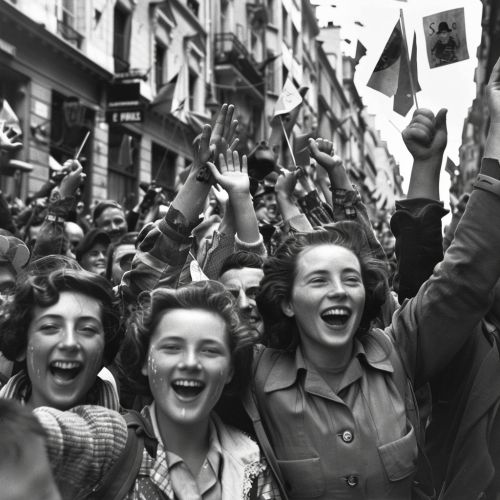Victory in Europe Day
Victory in Europe Day
Victory in Europe Day, commonly known as V-E Day or VE Day, marks the formal acceptance by the Allies of World War II of Nazi Germany's unconditional surrender of its armed forces on May 8, 1945. This event signified the end of World War II in Europe, although the war continued in other theaters until the surrender of Japan in September 1945.


Background
The origins of Victory in Europe Day can be traced back to the final stages of World War II. By early 1945, the Allied forces had successfully breached the Siegfried Line, a critical German defensive fortification, and were advancing into the heart of Germany. The Yalta Conference in February 1945 saw the Allied leaders, including Franklin D. Roosevelt, Winston Churchill, and Joseph Stalin, discussing the post-war reorganization of Europe and the final strategy for defeating Nazi Germany.
The relentless Allied bombing campaigns and the Soviet Union's advance from the east had left Germany in a state of disarray. The Battle of Berlin, which began in April 1945, was the final major offensive in the European theater. The city was encircled by Soviet forces, and intense urban combat ensued. Adolf Hitler, realizing the inevitability of defeat, committed suicide on April 30, 1945.
The Surrender
Following Hitler's death, Admiral Karl Dönitz assumed leadership of Germany and sought to negotiate a surrender that would be favorable to the Germans. However, the Allies demanded an unconditional surrender. On May 7, 1945, at the headquarters of the Supreme Allied Commander, General Dwight D. Eisenhower, in Reims, France, General Alfred Jodl signed the unconditional surrender documents on behalf of the German High Command. The surrender was to take effect at 23:01 Central European Time on May 8, 1945.
The formal ratification of the surrender took place the following day in Berlin, where Field Marshal Wilhelm Keitel signed the final documents in the presence of Soviet, American, British, and French representatives. This event marked the official end of the war in Europe.
Celebrations and Reactions
The announcement of Germany's surrender was met with widespread celebrations across the Allied nations. In the United Kingdom, large crowds gathered in Trafalgar Square and outside Buckingham Palace to cheer and wave flags. King George VI and Prime Minister Winston Churchill appeared on the balcony of Buckingham Palace to greet the jubilant crowds.
In the United States, President Harry S. Truman dedicated the victory to his predecessor, Franklin D. Roosevelt, who had died less than a month earlier. Celebrations erupted in cities across the country, with people dancing in the streets and holding impromptu parades.
In the Soviet Union, the news of the victory was received with immense relief and joy. The Soviet people had endured tremendous hardships during the war, and the victory was seen as a testament to their resilience and sacrifice. A massive victory parade was held in Moscow's Red Square on June 24, 1945.
Aftermath
The end of World War II in Europe marked the beginning of a new era in international relations and geopolitics. The Potsdam Conference, held in July-August 1945, saw the Allied leaders discussing the post-war order, including the disarmament and demilitarization of Germany, the establishment of occupation zones, and the prosecution of war criminals.
The war had left Europe in ruins, with millions of people displaced and economies devastated. The Marshall Plan, initiated by the United States in 1948, aimed to rebuild and stabilize the economies of Western Europe. The division of Germany into East and West, and the subsequent Cold War, were direct consequences of the geopolitical tensions that emerged in the aftermath of the war.
Legacy
Victory in Europe Day is commemorated annually on May 8 in many European countries and the United States. It serves as a reminder of the sacrifices made during World War II and the importance of peace and reconciliation. In Russia and other former Soviet states, Victory Day is celebrated on May 9, reflecting the time difference and the date of the final ratification of the surrender documents in Berlin.
The legacy of V-E Day is also reflected in the numerous memorials and monuments dedicated to the soldiers and civilians who lost their lives during the war. These include the National World War II Memorial in Washington, D.C., the Cenotaph in London, and the Motherland Calls statue in Volgograd, Russia.
